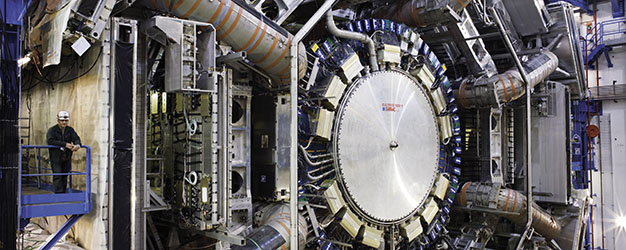High-Energy Physics
By colliding intense beams of high-energy particles, ETAP researchers are studying fundamental processes that have played an important role in the very early universe. After the discovery of the Higgs particle at the Large Hadron Collider, the focus is now on probing unexplored territory in search for new particles, including the elusive dark matter particles.
Dark Matter
While we know that 85% of the matter in the universe is “dark” -- i.e. does not interact with or emit light -- the fundamental nature of its constituents is so far unknown. As a most promising candidate, Weakly Interacting Massive Particles (WIMPs) have been sought for a long time, with the next generation of experiments now reaching a new sensitivity level. Next to major contributions to these experiments, ETAP researchers explore alternative possibilities such as hidden and axion-like particles.
Neutrinos
As neutrinos only interact weakly with other matter, they can act as unique probes that escape the most extreme astrophysical environments - yet are extremely difficult to detect. Initially thought to be massless, we also know today that neutrinos have “weight” -- a feature leading to the tantalizing phenomenon of neutrino oscillations in which neutrinos change their flavour in flight. From the USA via China to the South Pole, ETAP is involved in several experiments aiming to reveal the properties of the neutrinos themselves using accelerators, reactors or natural sources. But at the same time, they can act as messengers to study object far away in the universe.
Detector Development
Pushing the frontier in (astro-)particle physics calls for ever more sophisticated detectors with increasing sensitivity and precision. To search for rare or subtle processes these instruments require cutting-edge technology alongside with the ability to record data at exceedingly high rates.
Within the pronounced R&D efforts in ETAP, we therefore develop new detection technologies and precision instruments together with advanced read-out, triggering and data transfer electronics.
Within the pronounced R&D efforts in ETAP, we therefore develop new detection technologies and precision instruments together with advanced read-out, triggering and data transfer electronics.
For more information on the activities of the ETAP groups in each research area as well as contact persons, please select on topic from the left menu.
More details on the experiments and the physics that the ETAP groups are involved in, can be found under the section Experiments.







